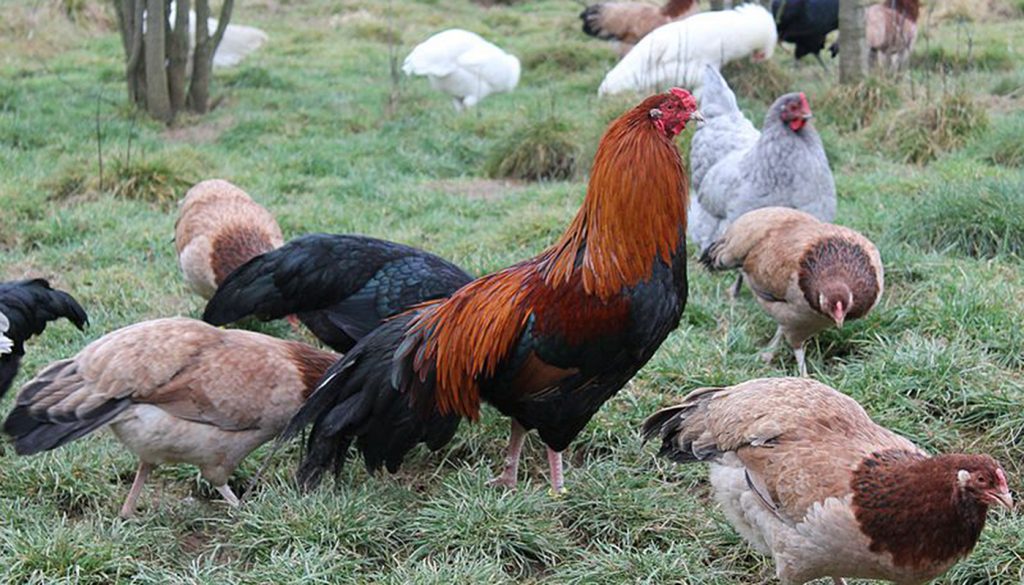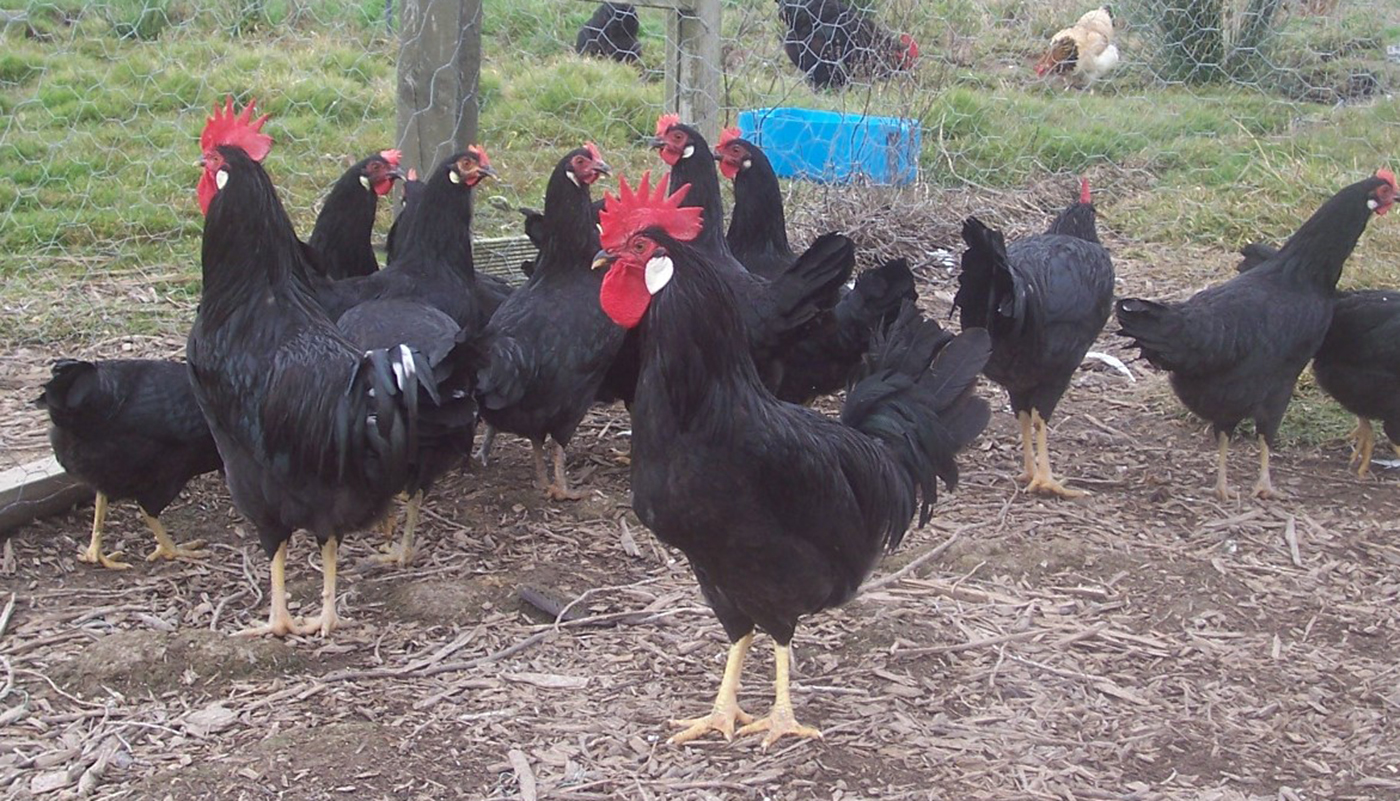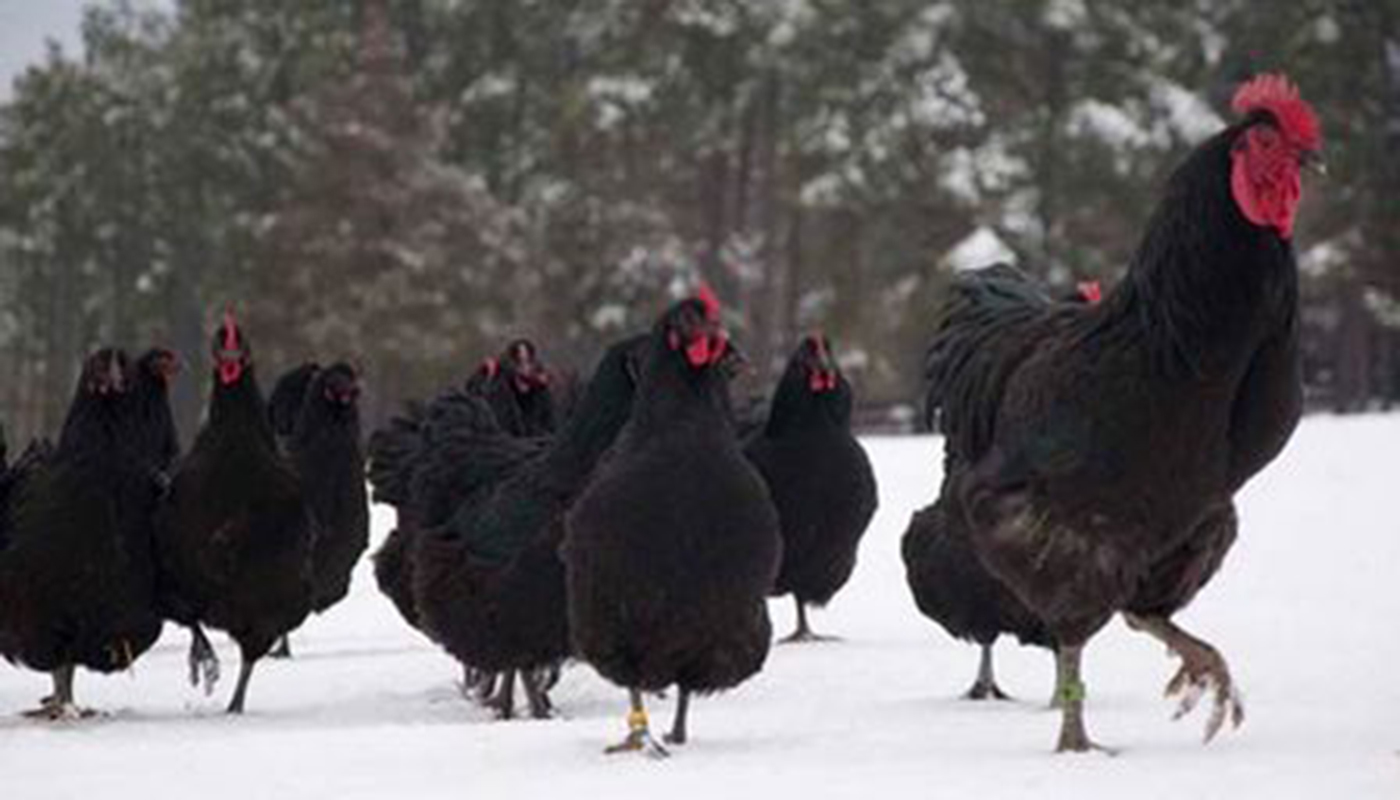
These lovely chickens are the result of breeding the Malay and Sumatra chickens brought to Cuba from the Philippines. The only official breed recognized by the Cuban National Poultry Association. Cubalaya were bred as a triple purpose chicken as they were meant for cockfighting as well as egg and meat production. These hens are great brood hens and make great foster moms, they are also very heated hardy birds that despite being a game bird have curious friendly natures. Their name Cubalaya was chosen in honor of the country that refined and patronized them the Republic of Cuba.
The game roosters were specifically developed to have little to no spurs to stop the male chicks from harming each other. These cute little chicks are really friendly and have been to know to feed off their owners’ hand from the first day they are born. They are also fearless babies that will not think twice about going in for the attack even against a snake if they have not been taught by an elder member of the flock.
| Country of Origin: | Cuba |
| American Poultry Association: | Recognized as a breed of chicken in the United States |
| Chicken Category: | Standard Breed |
| Chicken Class: | Oriental |
| Bantam Variety Available? | Yes – All Other Comb Clean Legged Bantam Classification |
| Good Starter Chicken? | They are low maintenance chickens very tame chicken |
PURPOSE⇒ |
Eggs: They are very good egg layers.
They lay medium cream tinted eggs from 200 a year They will lay consistently throughout winter and summer They start to lay eggs from around 24 weeks old.
Meat: They have white meat which is tender
Breeding: They can be bred and they hens do get broody they are also excellent mothers and brood hens.
If you are breeding the Cubalaya for show choosing the correct hens and rooster bloodline is crucial as well as the mix of the color variants.
Foraging: They love to scratch and forage about. They do not do well in confinement.
Show Bird: Their magnificent plumage and regal bearing them excellent show birds. They have a friendly easy to manage nature to their humans making them great on at a show as long as the roosters are kept apart.
Pets: Their curious friendly natures make them excellent pets.
Other: These gorgeous birds love to forage and do have the tendency to go in for the attack against predators such as snakes. Even the baby chicks tend to show no fear.
|
| Flyers? | They are good flyers |
| Noisy Birds? | Noisy, active and incredibly inquisitive chickens |
| Interaction with other chickens: | They do not get along too well with other breeds they have to be socialized well. As with any flock if you are introducing new birds it is best to slowly socialize them with the flock. |
| Good with kids? | They are good around supervised children some roosters have even been known to be quite protective over their human kids. |
HISTORY
Varieties of Asiatic game fowl were brought to Havana, Cuba in the mid-19th century. These game fowl had originated in the Phillippines.
These Asiatic breeds were crossed by the Cubans and then re-crossed with birds of European origins to create the Cubalaya.
The Cubalaya was bred independently from any scientific control and was designed to have a fierce/courageous expression, little to no spurs, curving beak and a flowing extended tail.
The breed was not only mean to be a dual-purpose bird for meat and eggs but as a game bird as well.
In 1939 the Cubalaya was shown for the first time in the USA at the International Poultry Exhibition. The American Poultry Association accepted the breed into the Standard of Perfection in the same year and the Bantam variety a little later that same year.
These birds have a stately carriage with a long flowing lobster tail are very friendly towards their humans and are excellent foragers.
CHARACTERISTICS |
|
|---|---|
IDENTIFICATION⇒ |
Appearance/Body: Cubalaya has bright red wattles, earlobes and comb. They upright carriage is almost stately in bearing with shiny plumage and a long abundant tail classified as a lobster tail which should be held about “20 degrees below horizontal”.
Color(s) Black, Black-breasted red and white
Comb: They have a pea comb
Ave. Weight: Pullet/Hen 6 lbs.
Cockerel/Rooster 7 lbs. |
| Life Expectancy: | The average lifespan is 8 years |
| Health: | They have no known health issues and can withstand hot climates. |
| You may Also Like: | HOW TO TELL IS A CHICKEN IS SICK |
| Temperament: | They are friendly and curious but can be aggressive towards other chickens. |
| Socialize Behavior? | Aggressive to chickens and can be cheeky towards other animals. |
| You may Also Like: | HOW TO SOCIALIZING YOUR NEW CHICKENS |
| Known predators: | Most domestic animals leave them alone due to their temperament, but it is always best to keep an eye on dogs and cats. If hawks and or foxes are in your area it is always best to take precautions. Check with local animal shelters, zoos, vets, animal control and or pet stores about common predators in your area. |
| Conservation Status: | These birds conservation status is recorded as “threatened”. It is best to check on any special license or instructions that may be set up for owning these birds. This can be checked with your local or national conservation centers. |
IDEAL ENVIRONMENT |
|
|---|---|
| Garden Size: | They do like to free range and forage about to stretch their legs. They prefer lots of nice grass to wander about on. They do not like to be confined. |
| Ideal Climate: | They are very hardy birds that handle the heat very well they may need some extra protection in extremely cold weather. |
| Ideal Coop: | The rule of thumb for any coop is 50 cm x 50 cm per hen/rooster in the coop. Ensure there is a good space for the nesting boxes and nightly roosting rails at least 1.5 inches wide. Good ventilation for air but not too drafty especially in winter. It is always a good idea to raise the coop off the ground to give the birds a dry place to roost and lay especially in wet weather. |
| Ideal Coop Run: | Cubalaya love to fly. It is best to fully cover the coop run to ensure your birds are in a safe secure environment. |
| Ideal Flock Size: | They are quite happy in any size flock as long as they have one companion to wander the gardens with. |
| Special Instructions: | Keep roosters apart as the males are very aggressive towards other males. |
| Accessories: | The following accessories are ideal for your coop: Nesting boxes Straw for the boxes and roosting area Roosting rails Perches Water troughs/bowls Food bowls/feeders Heating lamp(s) Animal carrier for transport purposes |
| You may Also Like: | 45 FREE DIY CHICKEN COOP PLANS, TUTORIALS AND DESIGNS |
WHERE TO FIND THESE BIRDS TO ADD TO YOUR FLOCK
The Cubalaya numbers are in a decline and are a source of concern for the Poultry conservation. These chickens may not be found at live poultry outlets and farms, it is best to check with the poultry clubs such as the Cubalaya Club of America website which will also have a host of valuable information. They will also be able to help with any special requirements, attention or care they may need. If you plan on breeding your chickens, you will want to make sure that they are from a good bloodline.
CARING FOR THE BIRD(S)
Please click here for our full guide to “Taking care of chickens”. This is a comprehensive guide to owning chickens. It covers where to start from choosing your ideal flock, the coop that would best suit your garden, your bird and you to buying and bringing your bird(s) home.
GENERAL
They are a low maintenance bird that is courageous and self-sufficient. They can take care of themselves and love to pick insects off the grassy outdoors.
GROOMING
These chickens do love their dust bath and will love some added herbal essences mixed into the loose sand to help with pests and excess feather oils. They may be a game bird, but they are game birds that are friendly and do not mind being handled for a regular examination for mites, lice and various other parasites. Checking for these pests in their feathers should be done at least once a week to keep your chickens healthy. Always get your birds de-wormed on a regular basis especially if they are around other animals or interacting with kids.
DIET AND NUTRITION
Give your Cubalaya a balanced diet of chicken pellets, grains, chicken mash or grain mix from 8 weeks old and older. This should be fed to them first thing in the morning before they are let out to roam about to ensure they are getting all their nutrients. You do not want them foraging about all day filling up on insects and not eating their regular food in the evenings.
For baby chickens, the best is always Chick Starter when they are under 8 weeks old.
Laying hens should get extra protein and calcium in their diets to ensure the quality of their eggs and to keep them in tip-top health.
Cubalaya does love getting table scraps in the form of vegetables and fruit. They find these scraps even better if they are served as ice-cubes on very hot days. They are quite happy to eat out of their human’s hands and are very careful when they do.
Feeding your chickens correctly will give your organic garden a lot of nutritious fertilizer to make your vegetables or flowers grow.
Please see our comprehensive guide to “Feeding your chickens” for more information of the different types of chicken feed for chicks, hens, laying hens, roosters, etc. and where to buy the feed and approximate cost of the feed.
SOCIALIZING THE BIRD(S)
Cubalaya may be a little difficult to socialize with other chickens.
Always check on how well a breed will get on with your current flock before buying them as you do not want to upset your coop or stress your current flock.
If you want to introduce another breed with your Cubalaya, try a breed that will not challenge them, or does not mind is lower down in the pecking order.
As with any newcomer to the roost, you will have to quarantine the bird for 7 – 31 days to ensure it does not have any unwanted critters or disease that could spread to your current flock.
Even the most gentle and sociable birds have a pecking order, so it is advisable to socialize them slowly and determine when it is right to allow the newcomer to become a permanent part of the flock.
NOTES / SPECIAL INSTRUCTIONS
As they are registered as a “threatened” conservation status they may need an extra license to own or keep in your garden. For advice on what the bird’s conservation status and orders are please check with your local conservation department.
For breeders, it is imperative that you always check your bird’s bloodlines and ensure you are buying your birds from a reputed breeder/farm. In order to sell birds of such stature, they have to be recorded and documented, always check with local animal breeding organizations for these records.
These legitimate documents are also required should you wish to show your bird(s) in various poultry shows/competition showings.
For information and advice on adopting rescued animals, you can visit or contact your local animal welfare center.
Video
USEFUL LINKS
- Caring for your Chicken
- Feeding
- Health
- Socializing your Chicken
- Breeding Chicken
- Raising Chickens A-Z
- Hatching Eggs
- What is Molting
- Animal Shelter (ASPCA)
- American Veterinary Medical Association
- American Poultry Association
- American Animal Welfare Society
- American Animal Control
- American Animal Husbandry Society
References
- https://en.wikipedia.org
- https://livestockconservancy.org
- https://www.roysfarm.com
- https://www.mypetchicken.com
- https://www.backyardchickens.com
- https://www.feathersite.com/
 BEST TEMPORARY/PORTABLE CHICKEN RUNS FOR THE BACK GARDEN TO BUY
BEST TEMPORARY/PORTABLE CHICKEN RUNS FOR THE BACK GARDEN TO BUY Minorca Chicken Breed – Everything You Need to Know
Minorca Chicken Breed – Everything You Need to Know The Zodiac of Chickens: Matching Chicken Breeds to Astrological Signs
The Zodiac of Chickens: Matching Chicken Breeds to Astrological Signs CONDITIONS THAT AFFECT THE A CHICKENS FEATHERS
CONDITIONS THAT AFFECT THE A CHICKENS FEATHERS Cockerels and Roosters
Cockerels and Roosters Easter Egger Chicken Breed – Everything You Need to Know
Easter Egger Chicken Breed – Everything You Need to Know Jersey Giant Chicken Breed – Everything You Need to Know
Jersey Giant Chicken Breed – Everything You Need to Know Legbar Chicken Breed – Everything You Need to Know
Legbar Chicken Breed – Everything You Need to Know Marans Chicken Breed – Everything You Need to Know
Marans Chicken Breed – Everything You Need to Know Malay Chicken Breed – Everything You Need to Know
Malay Chicken Breed – Everything You Need to Know Houdan Chicken Breed – Everything You Need to Know
Houdan Chicken Breed – Everything You Need to Know CONDITIONS THAT AFFECT THE NERVOUS SYSTEM OF CHICKENS
CONDITIONS THAT AFFECT THE NERVOUS SYSTEM OF CHICKENS